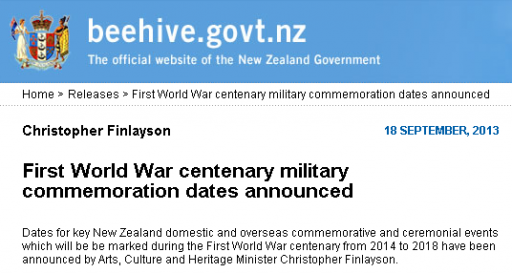The Government of New Zealand has announced the dates of domestic and overseas commemorative and ceremonial events during the Centenary.
Christopher Finlayson, New Zealand’s Minister for Arts, Culture and Heritage said that the commemorative programme had “been designed to allow New Zealanders living at home and overseas to commemorate those aspects of the First World War that are important to their families”.
Commemorations in New Zealand
25th April 2015 – Anzac landings in Gallipoli commemoration, at the National War Memorial
15th September 2016 – War in France commemoration, at the National War Memorial
12th October 2017 – War in Belgium commemoration, at the National War Memorial
October/November 2017 – War in Sinai/Palestine, at the National War Memorial
11th November 2018 – Armistice, at the National War Memorial
Commemorations overseas
25th April 2015 – Anzac landings at Gallipoli commemoration, Turkey
15th September 2016 – Battle of the Somme commemoration, France
7th June 2017 – Battle of Messines commemoration, Belgium
12th October 2017 – Battle of Passchendaele commemoration, Belgium
31st October 2017 – Battle of Beersheba commemoration, Israel
4th November 2018 – Liberation of Le Quesnoy commemoration, France
80% of casualties
New Zealand’s commemoration programme emphasises the Western Front, where over 80% of New Zealand’s casualties were suffered.
New Zealand will also be involved in a range of other commemorations including those marking the outbreak of war, the capture of German Samoa and the departure of the Anzac convoys from Albany in Western Australia.
“It is expected that New Zealand will be officially represented at other nations’ centenary ceremonies and other centennial events”.
Minister Finlayson stated the dates chosen “will provide key focal points for the commemoration of the First World War”.
“New Zealand’s programme to mark the centenary of the war, WW100, includes a range of other commemorative and related events that will leverage off these key military commemorations, including those that explore social and other non-military impacts of the war.”
One person in ten of New Zealand’s then population of 1,000,000 served overseas during the First World War, of whom more than 18,000 died and over 40,000 were wounded.
Background information
Gallipoli (25 April 1915)
Gallipoli marks the first major combat role for New Zealand forces in the First World War and is where the Anzac relationship was founded. 2,721 New Zealanders were killed in the campaign. Gallipoli is often considered to mark the beginning of a blossoming of national consciousness in both New Zealand and Australia; in addition to laying the foundations for the emergence of modern Turkey.
The Somme (15 September 1916)
The Somme Offensive was the first action undertaken by the New Zealand Division on the Western Front. On 15 September 1916 the New Zealand Division saw action at Morval and Thiepval Ridge. This action is also known as the Battle of Longueval. New Zealand suffered over 8,000 causalities and 2,000 deaths during the Somme Offensive.
Messines (7 June 1917)
Messines refers to a ridge south of the town of Ypres (Ieper today) captured by New Zealand forces. Thanks to careful planning, the capture of Messines Ridge was a stunning success and paved the way for the main attack later in the summer by removing German forces from the dominating ground on the southern face of the Ypres Salient. New Zealand suffered 3,000 causalities and 700 deaths at Messines.
Passchendaele (12 October 1917)
The 12 October 1917 attack by New Zealand forces on Bellevue Spur near Passchendaele was poorly prepared, partly because of the extreme weather conditions. The New Zealanders were exposed to German machine-gun fire along with being held back by barbed wire. Within the first few hours the New Zealand Division suffered 2,700 casualties, of which 845 were fatalities. These casualties amounted to six percent of New Zealand’s total casualties in the entire First World War.
Beersheba, Palestine (31 October 1917)
Beersheba was considered the key to taking Gaza due its strategically vital water wells. Allied divisions attacked the main Ottoman defences on the western and south-western outskirts of Beersheba on 31 October 1917. The New Zealand Mounted Rifles played a vital role in the Battle of Beersheba, aiding the Australian forces in their role of capturing the town and the eventual capture of Gaza from Ottoman forces.
Le Quesnoy (4 November 1918)
The New Zealand Division’s last major action of the war was the capture of the French town of Le Quesnoy which had been occupied by German forces from August 1914. The New Zealanders scaled the ancient walls with ladders and took the German garrison prisoners. The town’s liberation was achieved without loss of civilian life or destruction of the ancient fortifications. The liberation of Le Quesnoy represents one of the high points of the war and the town’s residents have maintained close links with, and a high regard for New Zealand ever since.
Source: New Zealand Government press release
Date of press release: 18/09/2013
Images courtesy of the New Zealand Goverment
Posted by: Daniel Barry, Centenary News
